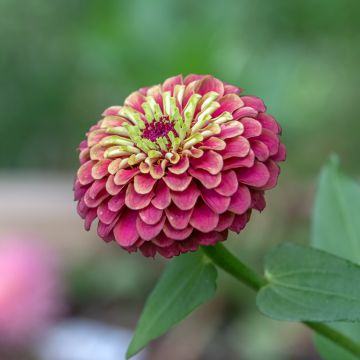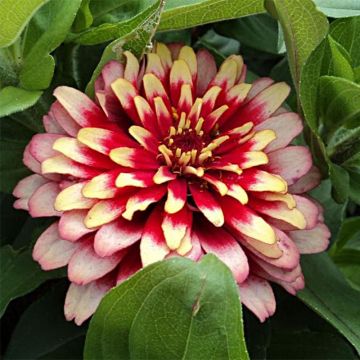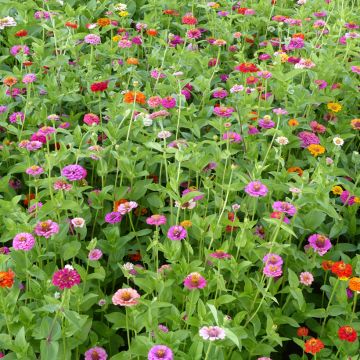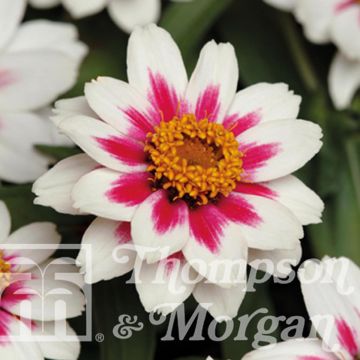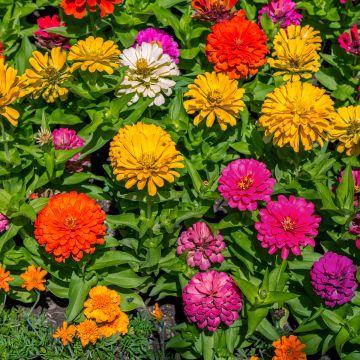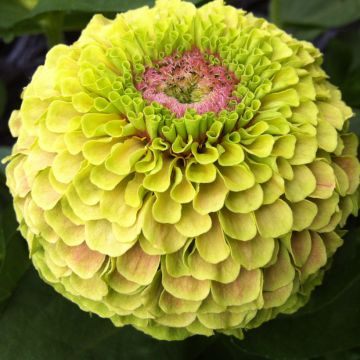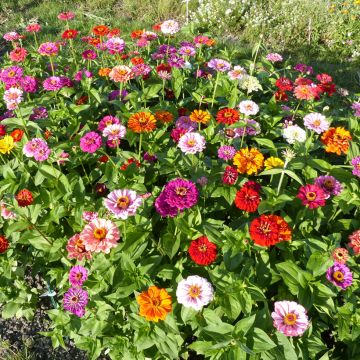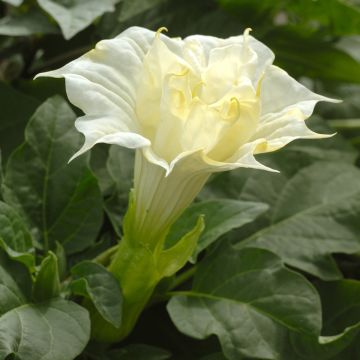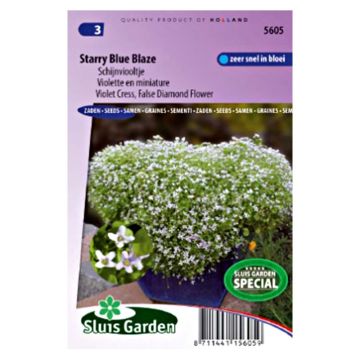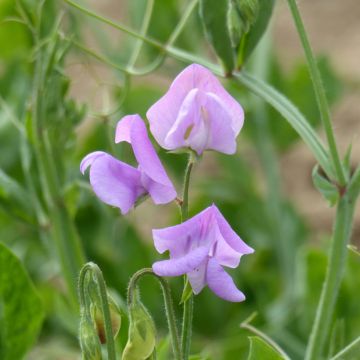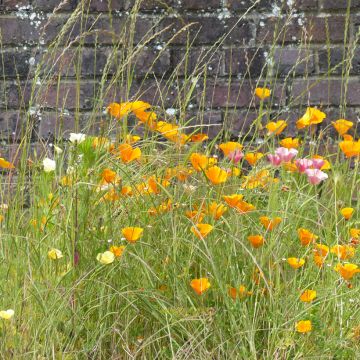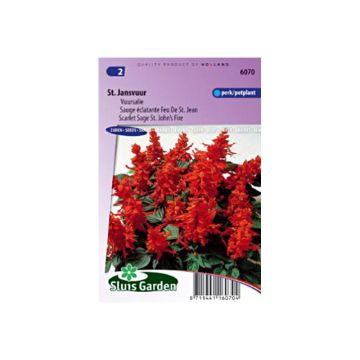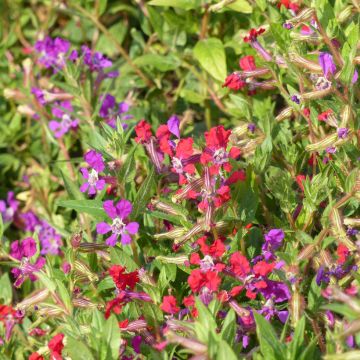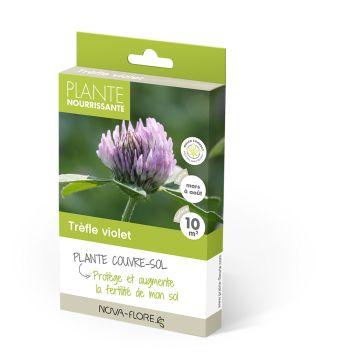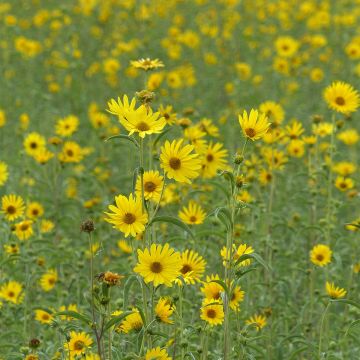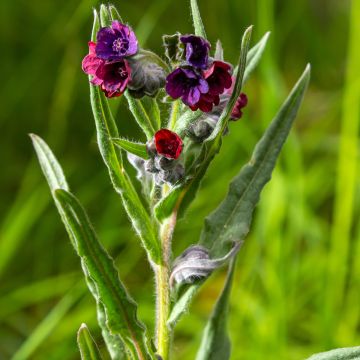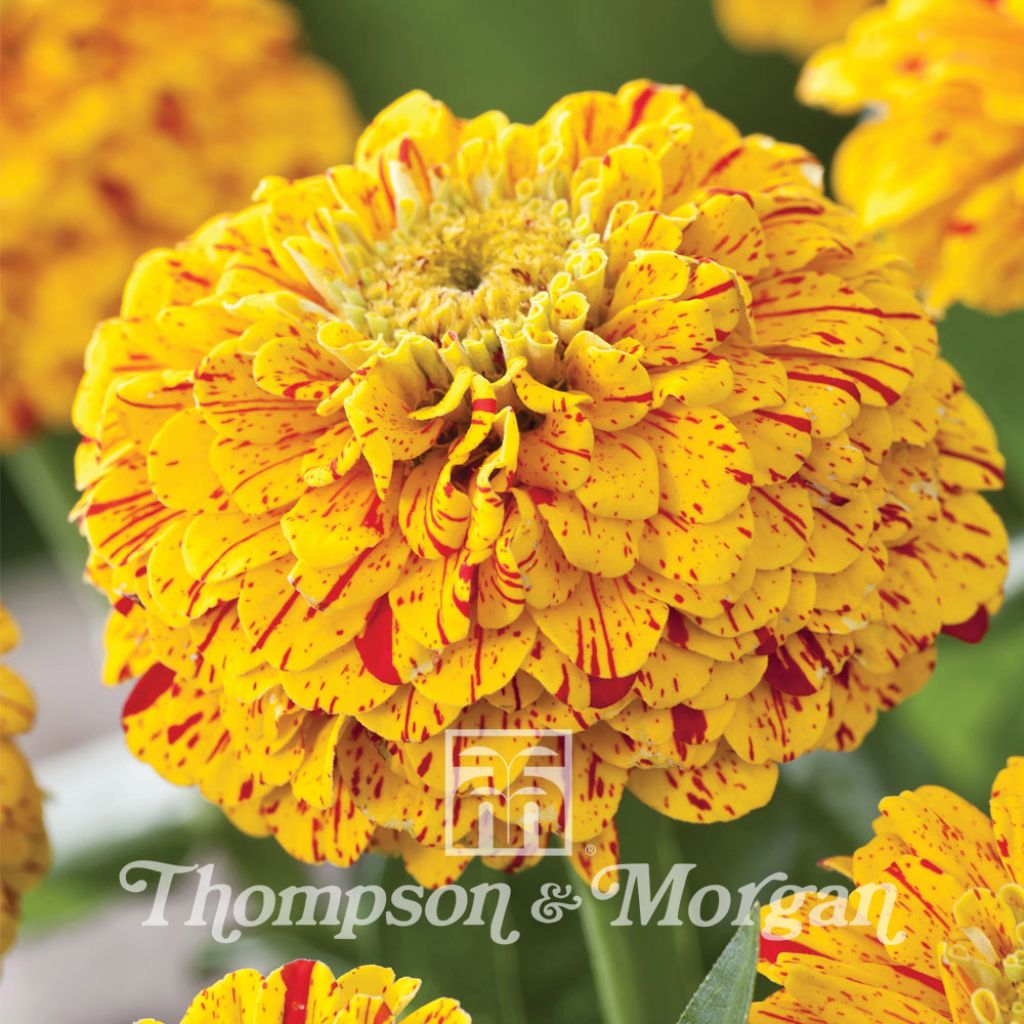

Zinnia Elegans Pop Art Golden & Red
Zinnia elegans Pop Art Golden & Red
Zinnia x elegans Pop Art Golden & Red
Common Zinnia, Elegant Zinnia, Youth-and-old-age
This plant carries a 6 months recovery warranty
More information
We guarantee the quality of our plants for a full growing cycle, and will replace at our expense any plant that fails to recover under normal climatic and planting conditions.
Seed-only orders are dispatched by sealed envelope. The delivery charge for seed-only orders is €3.90.

Does this plant fit my garden?
Set up your Plantfit profile →
Description
Zinnia elegans 'Pop Art Golden & Red' is a magnificent award-winning variety. The golden yellow pompom flowers are finely striated and splashed with scarlet red. Very bright, vigorous, and floriferous, it will brighten up your flower beds all summer long. It also makes superb bouquets.
Highly appreciated for their robustness, vibrant colours, and ease of cultivation, Zinnias are a reliable choice for the garden. Versatile, they can be used in borders, flower beds, or even in vegetable gardens, between the rows of vegetables.
Zinnia elegans 'Pop Art Golden & Red' has a medium habit, with a height of 60cm (24in) and a width of 30cm (12in). It can be easily paired, either in flower beds or in vegetable gardens, with other annuals such as Coreopsis, Sulphur Cosmos, and African Marigolds.
Native to the southern United States to Argentina and belonging to the Asteraceae family, Zinnia is an herbaceous annual plant. It bears vigorous flowers with vibrant colours on stiff, upright stems, with the size and shape varying depending on the variety. Its leaves, linear to ovate, are pointed and a beautiful medium green. Zinnia flowers generously, starting from July and lasting until the first frost. It is a nectar-rich plant that will delight bees and butterflies.
Zinnia thrives in full sun and withstands high temperatures, as long as it is watered regularly. It performs best in neutral, rich, and well-drained soil. Although not demanding, it can tolerate average garden soil.
To encourage and support its long flowering period, it is advisable to regularly remove faded flowers. Easy to grow, it can occasionally be susceptible to powdery mildew, a nuisance that can be easily avoided by not planting it in a confined area and avoiding wetting its foliage.
Report an error about the product description
Flowering
Foliage
Plant habit
Botanical data
Zinnia
x elegans
Pop Art Golden & Red
Asteraceae
Common Zinnia, Elegant Zinnia, Youth-and-old-age
Cultivar or hybrid
Other Zinnia seeds
Planting and care
Sow the seeds of Zinnia 'Pop Art Golden & Red' directly, from April to May, in loosened and warmed soil. Do not bury the seeds too deeply (3mm is sufficient) and space them 30cm (12in) apart. Keep the soil moist until germination, which usually takes between 7 and 14 days.
For early flowering, sow from March to April (indoors, at a temperature ranging from 15 to 25°C (59 to 77°F)) in a tray filled with good seed compost that you keep moist but not waterlogged. When the plants are large enough to handle, transplant them into pots. Gradually acclimatize your Zinnias to cooler conditions for about two weeks before planting them in the garden, once the risk of frost has passed. Space the plants 30cm (12in) apart.
Zinnia thrives in the sun and withstands high temperatures, as long as you remember to water it a little. It performs best in neutral, rich, and well-drained soil. Although not very demanding, it will still tolerate a garden soil that is just adequate. It can occasionally be susceptible to powdery mildew, a nuisance that can be easily avoided by not planting it in a confined location and being careful not to wet its foliage. Be cautious during planting as slugs are fond of their young tender leaves.
Sowing period
Intended location
-
, onOrder confirmed
Reply from on Promesse de fleurs
Flower seeds
Haven't found what you were looking for?
Hardiness is the lowest winter temperature a plant can endure without suffering serious damage or even dying. However, hardiness is affected by location (a sheltered area, such as a patio), protection (winter cover) and soil type (hardiness is improved by well-drained soil).

Photo Sharing Terms & Conditions
In order to encourage gardeners to interact and share their experiences, Promesse de fleurs offers various media enabling content to be uploaded onto its Site - in particular via the ‘Photo sharing’ module.
The User agrees to refrain from:
- Posting any content that is illegal, prejudicial, insulting, racist, inciteful to hatred, revisionist, contrary to public decency, that infringes on privacy or on the privacy rights of third parties, in particular the publicity rights of persons and goods, intellectual property rights, or the right to privacy.
- Submitting content on behalf of a third party;
- Impersonate the identity of a third party and/or publish any personal information about a third party;
In general, the User undertakes to refrain from any unethical behaviour.
All Content (in particular text, comments, files, images, photos, videos, creative works, etc.), which may be subject to property or intellectual property rights, image or other private rights, shall remain the property of the User, subject to the limited rights granted by the terms of the licence granted by Promesse de fleurs as stated below. Users are at liberty to publish or not to publish such Content on the Site, notably via the ‘Photo Sharing’ facility, and accept that this Content shall be made public and freely accessible, notably on the Internet.
Users further acknowledge, undertake to have ,and guarantee that they hold all necessary rights and permissions to publish such material on the Site, in particular with regard to the legislation in force pertaining to any privacy, property, intellectual property, image, or contractual rights, or rights of any other nature. By publishing such Content on the Site, Users acknowledge accepting full liability as publishers of the Content within the meaning of the law, and grant Promesse de fleurs, free of charge, an inclusive, worldwide licence for the said Content for the entire duration of its publication, including all reproduction, representation, up/downloading, displaying, performing, transmission, and storage rights.
Users also grant permission for their name to be linked to the Content and accept that this link may not always be made available.
By engaging in posting material, Users consent to their Content becoming automatically accessible on the Internet, in particular on other sites and/or blogs and/or web pages of the Promesse de fleurs site, including in particular social pages and the Promesse de fleurs catalogue.
Users may secure the removal of entrusted content free of charge by issuing a simple request via our contact form.
The flowering period indicated on our website applies to countries and regions located in USDA zone 8 (France, the United Kingdom, Ireland, the Netherlands, etc.)
It will vary according to where you live:
- In zones 9 to 10 (Italy, Spain, Greece, etc.), flowering will occur about 2 to 4 weeks earlier.
- In zones 6 to 7 (Germany, Poland, Slovenia, and lower mountainous regions), flowering will be delayed by 2 to 3 weeks.
- In zone 5 (Central Europe, Scandinavia), blooming will be delayed by 3 to 5 weeks.
In temperate climates, pruning of spring-flowering shrubs (forsythia, spireas, etc.) should be done just after flowering.
Pruning of summer-flowering shrubs (Indian Lilac, Perovskia, etc.) can be done in winter or spring.
In cold regions as well as with frost-sensitive plants, avoid pruning too early when severe frosts may still occur.
The planting period indicated on our website applies to countries and regions located in USDA zone 8 (France, United Kingdom, Ireland, Netherlands).
It will vary according to where you live:
- In Mediterranean zones (Marseille, Madrid, Milan, etc.), autumn and winter are the best planting periods.
- In continental zones (Strasbourg, Munich, Vienna, etc.), delay planting by 2 to 3 weeks in spring and bring it forward by 2 to 4 weeks in autumn.
- In mountainous regions (the Alps, Pyrenees, Carpathians, etc.), it is best to plant in late spring (May-June) or late summer (August-September).
The harvesting period indicated on our website applies to countries and regions in USDA zone 8 (France, England, Ireland, the Netherlands).
In colder areas (Scandinavia, Poland, Austria...) fruit and vegetable harvests are likely to be delayed by 3-4 weeks.
In warmer areas (Italy, Spain, Greece, etc.), harvesting will probably take place earlier, depending on weather conditions.
The sowing periods indicated on our website apply to countries and regions within USDA Zone 8 (France, UK, Ireland, Netherlands).
In colder areas (Scandinavia, Poland, Austria...), delay any outdoor sowing by 3-4 weeks, or sow under glass.
In warmer climes (Italy, Spain, Greece, etc.), bring outdoor sowing forward by a few weeks.

































